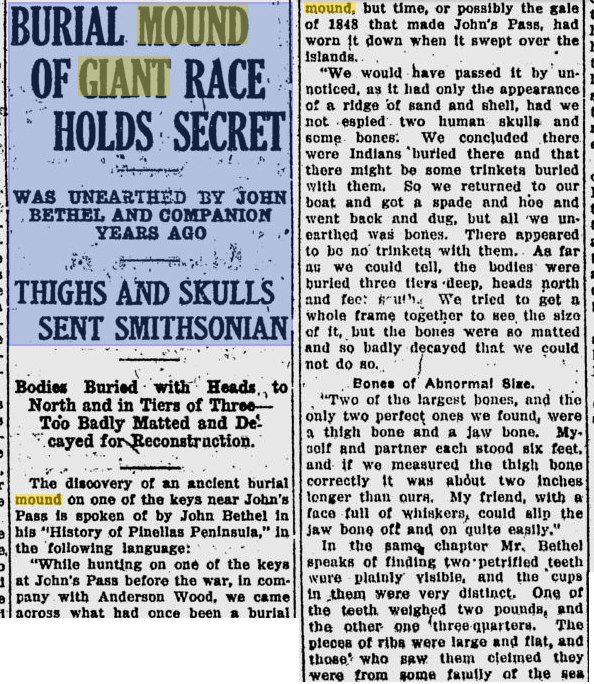John’s Pass, abnormal bones
 BURIAL MOUND OF GIANT RACE HOLDS SECRET
BURIAL MOUND OF GIANT RACE HOLDS SECRET
WAS UNEARTHED BY JOHN BETHEL, AND COMPANION YEARS AGO
THIGHS AND SKULLS SENT SMITHSONIAN
Bodies Buried with Heads., to North and in Tiers in Three- Too badly matted and Decayed for Reconstruction.
The discovery of an ancient burial mound on one of the keys near John’s Pass is described by John Bethel in his “History of Pinellas Peninsula” as follows:
“While hunting on one of the keys at John’s Pass before the war, in company with Anderson Wood, we came across what had once been a burial mound, but time, or possibly the gale of 1848 that made John’s Pass, had worn it down when it swept over the islands.
“We would have passed it by unnoticed, as it had only the appearance of a ridge of sand and shell, had we not espied two human skulls and some bones. We concluded that there were Indians buried there and that there might be some trinkets buried with them. So we returned to our boat and got a spade and hoe and went back and dug, but all we unearthed was bones.
“There appeared to be no trinkets with them, and as far as we could tell, the bodies were buried three tiers deep, heads pointing north and feet south. We tried to put a whole frame together to see the size of it, but the bones were so matted and so badly decayed that we could not do so.
“Bones of Abnormal Size.
“Two of the largest bones, and the only two perfect ones we found, were a thigh bone and a jaw bone. Myself and my partner each stood six feet, and if we measured the thigh bone correctly, it was about two inches longer than ours. My friend, with a face full of whiskers, could slip the jaw bone off and on quite easily.”
In the same chapter, Mr. Bethel mentions finding two petrified teeth with clearly visible cups. One of the teeth weighed two pounds, and the other weighed three-quarters of a pound. Pieces of ribs were also discovered, which were large and flat. Some who saw them claimed they were from a family of the sea.
1. St. Petersburg Daily Times, March 17, 1914

Comment